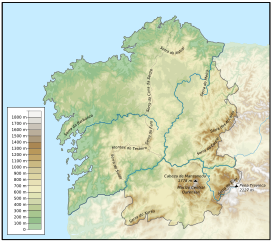Galician Massif
| Galician Massif | |
|---|---|
| Macizo Galaico | |

View of Cabeza de Manzaneda in winter
|
|
| Highest point | |
| Peak | Pena Trevinca |
| Elevation | 2,127 m (6,978 ft) |
| Coordinates | 42°14′33″N 6°47′45″W / 42.24250°N 6.79583°W |
| Geography | |
| Country | Spain |
| States/Provinces | Galicia and Castile and León |
| Range coordinates | 42°30′N 8°6′W / 42.500°N 8.100°WCoordinates: 42°30′N 8°6′W / 42.500°N 8.100°W |
| Geology | |
| Orogeny | Variscan orogeny |
| Age of rock | Paleozoic |
| Type of rock | Schist, gneiss and granite |
The Galician Massif, Spanish: Macizo Galaico, also known as Macizo Galaico-Leonés, is a system of mountain ranges in the northwestern corner of the Iberian Peninsula. It is located in Galicia with its southeastern end reaching into the provinces of Zamora and León of Castile and León. Its highest point is Pena Trevinca at 2,127 metres (6,978 ft) . Another important peak is Cabeza de Manzaneda (1,781 m).
In traditional local folklore the forests of the Galician System are said to be inhabited by a variety of elves, fairies, ghosts, the Santa Compaña, the Nubeiro and witches (meigas).
Geomorphologically the Galician Massif is a northwestern prolongation of the Meseta Central, the inner Iberian plateau and has great affinity with the geology of the Tras os Montes Portuguese region, so that it is considered as a whole under the name 'Galicia-Trás-os-Montes Zone'. It is composed of Paleozoic materials (granite) with metamorphic rocks such as gneiss, slate and schist in the center and west, which were subject to Alpine folding. Its eastern end merges with the Cantabrian Mountains.
...
Wikipedia

